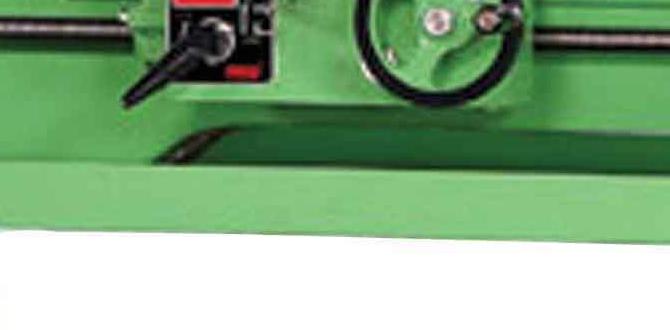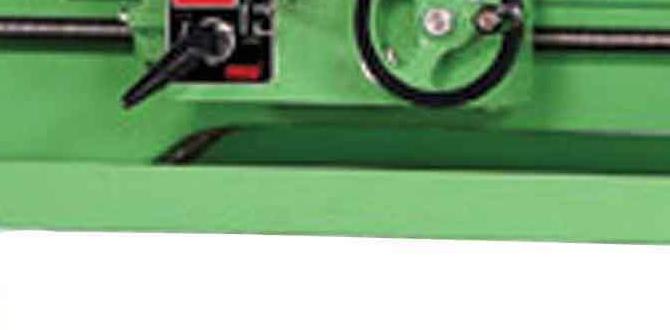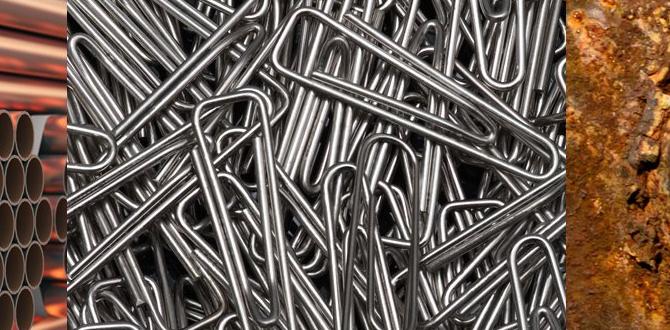Use a wood lathe turning speed chart to select the right RPM for safer and more efficient woodworking projects, preventing tear-out and motor strain. Correct speeds vary by wood type, diameter, and tool.
Getting the right speed on your wood lathe can feel like a riddle for beginners. Too fast, and your wood vibrates or even breaks apart. Too slow, and you fight the grain and get a rough finish. It’s a common stumbling block that can lead to frustration and even safety concerns. But don’t worry! With a simple wood lathe turning speed chart and a little understanding, you can dial in the perfect RPMs for almost any project. We’ll break down how these charts work and how to use them confidently, so you can focus on creating beautiful things. Let’s get turning!
Understanding Wood Lathe Turning Speed Charts
A wood lathe turning speed chart is your best friend when you’re starting out. It’s a handy reference that helps you figure out the ideal revolutions per minute (RPM) for your lathe based on a few key factors. Think of it like a recipe – the ingredients (wood size, type) tell you how hot to set your oven (lathe speed).
Why is this so important? Wood is a natural material, and it behaves differently depending on its density, diameter, and even moisture content. Using the wrong speed can lead to:
- Catastrophic Breakage: Especially with larger or unbalanced pieces, excessive speed can cause the wood to fly off the lathe, which is incredibly dangerous.
- Poor Surface Finish: Too slow, and your tools might tear out fibers, leaving a rough, splintery surface that’s hard to sand.
- Tool Chatter: An incorrect speed can make your tools vibrate, leading to an uneven cut and making them wear out faster.
- Motor Strain: Running the lathe too fast or too slow for the workpiece can put unnecessary stress on the motor, shortening its lifespan.
A good wood lathe turning speed chart takes the guesswork out of this. It’s designed to keep you safe, improve your results, and make your lathe work more enjoyable. We’ll explore how to read these charts and when to make adjustments.
Key Factors That Influence Lathe Speed
Before we dive into specific charts, it’s crucial to understand what makes wood lathe speeds vary. Three main factors dictate the best RPM for your turning project:
1. Workpiece Diameter
This is usually the biggest factor. Larger diameter pieces need to spin slower. Imagine a point on the edge of a spinning record versus a point at the center. The edge point travels much further (and faster) in the same amount of time. On a lathe, the further out from the center your cutting tool is, the faster that wood surface is moving relative to your tool. So, a 12-inch diameter log needs to spin much slower than a 2-inch diameter dowel to achieve the same surface speed.
Think about friction and centrifugal force. A larger, faster-spinning workpiece has more momentum and generates more heat and force. Keeping this manageable is key to safety and control.
2. Wood Type and Density
Different types of wood have different densities and grain structures. Softwoods like pine are lighter and less dense, meaning they can sometimes be turned at slightly higher speeds without issues. Hardwoods like oak or maple are denser and tougher, often requiring slower speeds, especially during initial roughing.
Example: A piece of balsa wood would need very different handling than a piece of ebony. While you won’t typically be turning ebony on a beginner’s lathe, understanding that density matters will help you adapt. For most common hardwoods and softwoods, charts provide a good starting point.
The difference between hardwoods and softwoods impacts everything from tool choice to turning speed.
3. Type of Operation (Roughing, Shaping, Sanding)
The stage of your turning project also affects the ideal speed. You’ll typically use different speeds for different tasks:
- Roughing (Initial Shaping): When you’re first turning a square blank round or removing a lot of material, slower speeds are generally safer. This is especially true if your blank isn’t perfectly round or balanced.
- Detailing and Shaping: Once the piece is mostly round and you’re refining the shape, you can often increase the speed slightly for a cleaner cut.
- Sanding: For sanding, you usually want a moderate speed – fast enough to be efficient but slow enough to prevent burning and allow you to control the pressure. Some woodturners even slow down considerably for the final sanding stages.
- Spindle Turning vs. Faceplate Turning: Spindle turning (turning between centers, like legs for furniture) often allows for higher speeds than faceplate turning (turning flat objects like bowls or platters). Faceplate work, especially with larger diameters, carries a higher risk due to potential imbalance.
How to Read a Wood Lathe Turning Speed Chart
Most wood lathe turning speed charts are pretty straightforward. They are usually presented as a table with turning speed recommendations, often displayed in RPM. You’ll typically find:
- Diameter of Woodpiece (Inches): This column lists common workpiece diameters.
- Recommended RPM Range: This column provides the safe and effective speed settings for that diameter.
- Notes/Species: Sometimes, charts will include notes about specific wood types or operations.
Let’s look at a typical chart. Remember, these are general guidelines. Your specific lathe, tools, and experience might require minor adjustments.
Example Wood Lathe Turning Speed Chart (General Guidelines)
This chart provides a starting point. Always prioritize safety and listen to your lathe and workpiece.
| Workpiece Diameter (Inches) | Recommended RPM Range (Roughing/Shaping) | Recommended RPM Range (Sanding/Finishing) | Notes |
|---|---|---|---|
| 1-3 | 1200 – 2500 RPM | 700 – 1500 RPM | Generally safe for most woods. Can increase speed slightly for very soft woods. |
| 3-6 | 800 – 1800 RPM | 500 – 1200 RPM | Be cautious with unbalanced pieces. Softwoods can handle upper end, hardwoods lower. |
| 6-9 | 500 – 1200 RPM | 300 – 800 RPM | Crucial for safety. Imbalance is a major concern. Stick to lower end for hardwoods. |
| 9-12 | 300 – 800 RPM | 200 – 500 RPM | Only for well-balanced, stable wood. Lower speeds are essential. |
| 12+ | Slower than 500 RPM (often 200-400 RPM) | Slower than 300 RPM (often 100-250 RPM) | Extreme caution needed. Consider breaking down large turnings or using reduced speeds with specialized techniques. Consult advanced guides. |
Important Note: If your lathe has a variable speed dial, you’ll be setting the actual numerical RPM. If it has a belt-drive system with multiple pulley positions, you’ll be selecting a pulley combination that corresponds to a speed range. Always check your lathe’s manual for its specific speed ranges and how to adjust them.
Using the Chart Effectively
- Measure Your Workpiece: Determine the largest diameter you’ll be turning.
- Identify Your Wood: Is it a softwood (pine, poplar) or a hardwood (oak, maple, cherry)?
- Consider Your Stage: Are you roughing out, shaping, or sanding?
- Find the Intersection: Locate your diameter on the chart and choose a speed from the appropriate column (roughing, sanding). If you’re unsure, always err on the side of caution and choose a slower speed.
- Start Slow and Adjust: Begin at the lower end of the recommended RPM range. Gradually increase the speed if the cut is clean and the piece feels stable. If you hear vibration, see excessive dust, or feel any imbalance, slow down immediately.
For instance, if you’re turning a rough 8-inch diameter oak log to round it off, you’d look at the “6-9 inches” row and the “Roughing/Shaping” column. You’d start around 500 RPM and see how it feels. If you were sanding that same 8-inch piece, you’d look at the “Sanding/Finishing” column and aim for something between 300-800 RPM, likely starting lower.
Safety First: The Unspoken Rule of Lathe Speed
No chart can fully replace common sense and a healthy respect for the power of a spinning piece of wood. Safety is paramount when using a wood lathe, and speed is a major factor.
General Safety Tips Related to Speed:
- Wear Safety Gear: Always wear a full face shield, not just safety glasses. A dust mask is also essential.
- Secure Your Work: Ensure your workpiece is firmly mounted between centers or on a faceplate. Check that it’s not loose.
- Stationary Tooling: Keep your tools sharp and always rest them firmly on the tool rest. Never try to “catch” a wobbling piece with your tool.
- Start Slow with New Blanks: Especially when turning a square blank round, start at the slowest speed your lathe offers. Gradually increase the speed as the blank becomes more cylindrical and balanced.
- Listen and Watch: Pay attention to any vibrations, unusual noises, or wobbling. These are all signs that you need to slow down or stop.
- Never Use a Damaged Workpiece: Avoid turning wood with major cracks or checks, as these can cause it to break apart at speed.
- Keep Glued-Up Workpiece Speed Low: When turning bowls or platters made from several pieces of wood glued together, the glue lines can be weak points. Always adhere to lower speeds, especially for larger diameters.
- Clear Your Workspace: Keep the area around your lathe clean and free of obstructions.
`Woodworking is inherently dangerous. Only use machinery if you are properly trained and understand the risks involved. Always wear appropriate safety equipment. If you are unsure about any aspect of operating your lathe, seek guidance from an experienced woodturner or refer to your lathe’s manufacturer manual.
For more on woodworking safety, the Occupational Safety and Health Administration (OSHA) provides comprehensive guidelines, including those for woodworking machinery.
Choosing the Right Lathe Speed for Bowls vs. Spindles
While the general chart is useful, woodturners often use slightly different speed strategies for spindle turning (making things like chair legs, table legs, tool handles) versus faceplate turning (making bowls, platters, clock faces).
Spindle Turning (Between Centers)
Spindle turning typically involves turning round stock held between the headstock and tailstock. These pieces are generally more balanced than a large, thick-bored bowl blank, especially once they are turned round.
- Higher Potential Speeds: Because they are often more balanced, spindle turnings can sometimes be turned at higher RPMs than faceplate turnings of the same diameter.
- Roughing: Start slow, especially with square stock. Once it’s mostly round, you can often ramp up to the mid-to-high end of the chart’s recommended range for shaping.
- Sanding: Sanding spindle turnings can often be done at moderate to higher speeds, allowing for quick material removal.
Faceplate Turning (Bowls, Platters)
Turning bowls and platters involves mounting the wood to a faceplate or chuck attached to the headstock. These pieces, especially when starting with a thick, off-center blank, can be significantly unbalanced.
- Lower Speeds are Crucial: Imbalance creates strong forces that increase dramatically with speed. This is where a wood lathe turning speed chart is most critical. For larger diameter bowls, speeds might be surprisingly low.
- Roughing: Always start at the slowest speed. Gradually increase only if the piece is running true and stable. For very large or thick bowls, stay at lower speeds even after roughing.
- Sanding: Sanding bowls often requires slower speeds than spindle work of the same diameter to avoid burning and maintain control, especially on the rim.
Many experienced woodturners advocate for starting faceplate turning at speeds that feel very slow, perhaps even below what a chart suggests, and only increasing them cautiously as the workpiece becomes more perfectly round and balanced.
Troubleshooting Common Speed Issues
Even with a chart, you might encounter problems. Here’s how to address them:
Issue 1: Excessive Vibration
- Cause: Imbalance, cracks in the wood, workpiece not secure, or speed is too high for the diameter/shape.
- Solution: Slow down immediately. Check that the wood is securely held. If it’s a rough blank, continue at a very slow speed until it’s round. Inspect the wood for cracks.
Issue 2: Wood Splintering or “Picking”
This often happens when the tool isn’t sharp, the angle is wrong, or the speed is too slow, causing the tool to tear the grain rather than cut it cleanly.
- Cause: Dull tool, incorrect cutting angle, speed too slow, or wood type is prone to tear-out.
- Solution: Ensure your tools are razor-sharp. Try slightly increasing the speed if you are at the very low end of the range, but be cautious. Adjust your tool angle – aim for a scraping cut if necessary when dealing with difficult grain.
Issue 3: Burning on the Wood Surface
Too much friction, often caused by spinning too fast for the type of wood or the sanding process, can lead to burning.
- Cause: Speed too high for the wood type, dull tools causing friction due to poor cutting, or excessive pressure during sanding.
- Solution: Slow down the lathe. Ensure tools are sharp. If sanding, use the appropriate grit and don’t linger too long in one spot, especially with paper that’s too fine or at high speeds.
Issue 4: Tool “Chatter”
Vibration that transfers from the tool to the wood, leaving an uneven, ridged surface.
- Cause: Dull tools, incorrect tool rest position, workpiece imbalance, or speed is incorrect.
- Solution: Sharpen tools, adjust tool rest position (usually just below the center line for most cuts). Reduce speed if the piece is unbalanced or if it seems to correlate with a specific RPM.
Calculating Your Own Speeds (Optional)
While charts are great, advanced users might want to understand the physics. Surface speed, measured in feet per minute (FPM), is what matters for cutting. Most lathe manufacturers provide this information in their manuals. The idea is to maintain a desired surface speed, and then calculate the RPM based on your workpiece diameter.
The formula is:
RPM = (Desired Surface Speed in FPM 12) / (Pi Diameter in Inches)
Where Pi (π) is approximately 3.14159.
Example Calculation:
Let’s say you want a surface speed of 1500 FPM for a 6-inch diameter piece.
RPM = (1500 12) / (3.14159 6)
RPM = 18000 / 18.84954
RPM ≈ 955 RPM
This calculation shows that the chart’s range of 500-1200 RPM for a 6-inch piece is reasonable, with 955 RPM falling right in the middle, suitable for general shaping.
As you gain experience, you’ll develop an intuition for how a piece feels and sounds, allowing you to make slight adjustments to the recommended speeds. For now, a reliable chart and a cautious approach will serve you very well.
Frequently Asked Questions (FAQ)
Q1: What is the most important factor in determining wood lathe speed?
A1: The diameter of the workpiece is the most significant factor. Larger diameters must spin slower to




